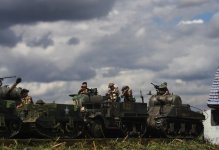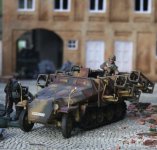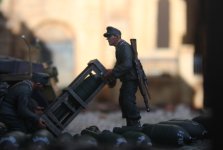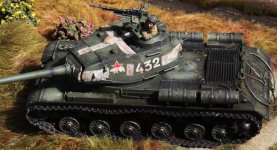panda1gen
Colonel
- Joined
- Jul 29, 2005
- Messages
- 8,162
That's a fancy way of saying horse meat!
Considering army cooking…probably nothing that feels good coming out! Ha!Hey Jake, what's for dinner?
Mike
Looks great Jake!View attachment 353895
Not a diorama - but I thought everyone would enjoy seeing a prototype palm I’m working on
You would be correct.View attachment 353895
Not a diorama - but I thought everyone would enjoy seeing a prototype palm I’m working on
That's Figarti, right? It seems like everybody did an H2 Sherman. I have an Honour Bound Gold and I've seen a K&C as well. Popular markings.
I think it is Figarti Louis.That's Figarti, right? It seems like everybody did an H2 Sherman. I have an Honour Bound Gold and I've seen a K&C as well. Popular markings.



A superb model and photograph. I'm lucky enough to have one of these, I got it from Clive back in the day. I truly miss having Figarti in the hobby. Thanks for posting KevinTo continue a Figarti theme .....
Ref: https://en.wikipedia.org/wiki/Wurfrahmen_40
Stuka zu Fuss
The Wurfrahmen 40 ("launch frame 40") was a German World War II multiple rocket launcher.
It combined a vehicle such as the Sd.Kfz. 251 halftrack .....
View attachment 354285
.... or captured French Renault UE Chenillette with rocket artillery to form a more mobile and protected artillery piece than the towed Nebelwerfer.
It was nicknamed Stuka zu Fuss ("Stuka on Foot" or "Walking Stuka") and Heulende Kuh ("Bellowing Cow").[1]
Introduced in late 1940, the weapon system was a framework with adjustable base plates fitted over and alongside a vehicle which could hold 300 mm high explosive (HE) rockets; 280 mm HE and 320 mm incendiary rockets were also used, the rockets being fired while in their loading crates.
View attachment 354286
Although spin stabilized, the rockets were not as accurate as conventional artillery, and reloading was time-consuming due to their weight.
Where feasible, rockets were ripple-fired in large numbers to quickly saturate a target.
The system was successful as a support weapon for mobile Panzer formations, particularly in urban areas.
When used on the common mounting, the Sd.Kfz. 251 halftrack, a frame with six base plates were used, with three on each side.
The Chenillette UE employed either two per side or four frames on the rear. The Hotchkiss H35 mounting used two per side also. Some captured American M3 halftracks also mounted Wurfrahmen, with four frames at two per side.[2]
Figart IS 2 tank .....A superb model and photograph. I'm lucky enough to have one of these, I got it from Clive back in the day. I truly miss having Figarti in the hobby. Thanks for posting Kevin


Thanks Kevin, 2 more splendid modelsFigart IS 2 tank .....
View attachment 354317
Ref: https://en.wikipedia.org/wiki/IS-2
This is a short excerpt from the above web page.
IS 2 Combat History
The IS-2 tank first saw combat in early 1944, equipping elite Guards Heavy Tank Regiments of the Red Army. A regiment had 21 IS-2 tanks in four companies of five tanks each and one being used by the regimental commander.[28]
The special tank regiments were reserved for important attacks, often to spearhead attempts to break through fortified German positions like anti-tank defence lines and bunkers.[28]
The tanks supported infantry in the assault by destroying bunkers, buildings, dug-in weapons and engaging German armoured vehicles.
Once a breakthrough was achieved, lighter and more mobile tanks were used for exploitation and mopping-up. The IS-2 tank first saw action in Ukraine in early 1944 and claimed to have destroyed more than forty Tigers and Elefants for the loss of only eight tanks.
On the morning of 11 August 1944, the 16th Panzer Division attacked the 53rd Guards Tank Brigade reinforced by the 71st Independent Guards Heavy Tank Regiment in the town of Oględów, toward Staszów. The extremely sandy terrain forced the eleven King Tigers to keep to the roads, whilst the defending Soviet forces positioned their tanks and assault guns in ambush positions and concentrated on the known German avenues of approach.[29]
When the attack started, three Tiger IIs were destroyed by fire from Soviet IS-2 tanks at a range of 800 m (2,600 ft), and one more Tiger II was knocked out a few hours later by a T-34/76 at a range of less than 400 m (1,300 ft).
Later in the day, Soviet forces counter-attacked and seized the town of Oględów and found three abandoned Tiger IIs. The capture of these tanks allowed the Soviets to conduct tests at Kubinka and to evaluate its strengths and weaknesses.[30]
View attachment 354316
This was the Figarti give away at one of the Chicago Shows back in the day. Great photo, Kevin!Brian, you are welcome. I shall post some more in due course.
Meanwhile, a Figarti man and his dog ...
View attachment 354318

